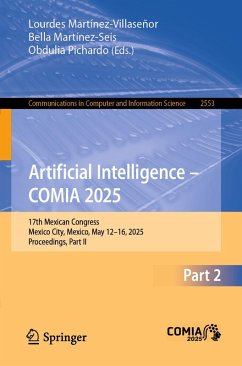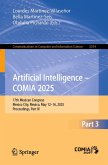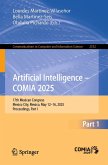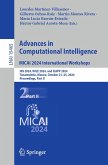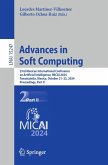Artificial Intelligence - COMIA 2025 (eBook, PDF)
17th Mexican Congress, Mexico City, Mexico, May 12-16, 2025, Proceedings, Part II
Redaktion: Martínez-Villaseñor, Lourdes; Pichardo, Obdulia; Martínez-Seis, Bella


Alle Infos zum eBook verschenken

Artificial Intelligence - COMIA 2025 (eBook, PDF)
17th Mexican Congress, Mexico City, Mexico, May 12-16, 2025, Proceedings, Part II
Redaktion: Martínez-Villaseñor, Lourdes; Pichardo, Obdulia; Martínez-Seis, Bella
- Format: PDF
- Merkliste
- Auf die Merkliste
- Bewerten Bewerten
- Teilen
- Produkt teilen
- Produkterinnerung
- Produkterinnerung

Hier können Sie sich einloggen

Bitte loggen Sie sich zunächst in Ihr Kundenkonto ein oder registrieren Sie sich bei bücher.de, um das eBook-Abo tolino select nutzen zu können.
The 3-volume set CCIS 2552 - 2554 constitutes the proceedings of the 17th Mexican Conference on Artificial Intelligence, COMIA 2025, which took place in Mexico City, Mexico, during May 12-16, 2025.
The totel of 83 papers included in the proceedings was carefully reviewed and selected from 199 submissions. They were organized in topical sections as follows:
Part I: Natural languages processing; robotics; signal processing; ethics and regulation;
Part II: Computer Vision and Image Processing; Deep Learning; Machine Learning and Pattern Recognition; Data Mining;
Part III: Artificial intelligence applications; medical applications.…mehr
- Geräte: PC
- ohne Kopierschutz
- eBook Hilfe
- Größe: 52.82MB
![Artificial Intelligence - COMIA 2025 (eBook, PDF) Artificial Intelligence - COMIA 2025 (eBook, PDF)]() Artificial Intelligence - COMIA 2025 (eBook, PDF)68,95 €
Artificial Intelligence - COMIA 2025 (eBook, PDF)68,95 €![Artificial Intelligence - COMIA 2025 (eBook, PDF) Artificial Intelligence - COMIA 2025 (eBook, PDF)]() Artificial Intelligence - COMIA 2025 (eBook, PDF)72,95 €
Artificial Intelligence - COMIA 2025 (eBook, PDF)72,95 €![Advances in Computational Intelligence (eBook, PDF) Advances in Computational Intelligence (eBook, PDF)]() Advances in Computational Intelligence (eBook, PDF)46,95 €
Advances in Computational Intelligence (eBook, PDF)46,95 €![Advances in Computational Intelligence. MICAI 2024 International Workshops (eBook, PDF) Advances in Computational Intelligence. MICAI 2024 International Workshops (eBook, PDF)]() Advances in Computational Intelligence. MICAI 2024 International Workshops (eBook, PDF)40,95 €
Advances in Computational Intelligence. MICAI 2024 International Workshops (eBook, PDF)40,95 €![Advances in Computational Intelligence. MICAI 2024 International Workshops (eBook, PDF) Advances in Computational Intelligence. MICAI 2024 International Workshops (eBook, PDF)]() Advances in Computational Intelligence. MICAI 2024 International Workshops (eBook, PDF)52,95 €
Advances in Computational Intelligence. MICAI 2024 International Workshops (eBook, PDF)52,95 €![Advances in Computational Intelligence (eBook, PDF) Advances in Computational Intelligence (eBook, PDF)]() Advances in Computational Intelligence (eBook, PDF)88,95 €
Advances in Computational Intelligence (eBook, PDF)88,95 €![Advances in Soft Computing (eBook, PDF) Advances in Soft Computing (eBook, PDF)]() Advances in Soft Computing (eBook, PDF)46,95 €
Advances in Soft Computing (eBook, PDF)46,95 €-
-
-
The totel of 83 papers included in the proceedings was carefully reviewed and selected from 199 submissions. They were organized in topical sections as follows:
Part I: Natural languages processing; robotics; signal processing; ethics and regulation;
Part II: Computer Vision and Image Processing; Deep Learning; Machine Learning and Pattern Recognition; Data Mining;
Part III: Artificial intelligence applications; medical applications.
Dieser Download kann aus rechtlichen Gründen nur mit Rechnungsadresse in A, B, BG, CY, CZ, D, DK, EW, E, FIN, F, GR, HR, H, IRL, I, LT, L, LR, M, NL, PL, P, R, S, SLO, SK ausgeliefert werden.
- Produktdetails
- Verlag: Springer International Publishing
- Seitenzahl: 356
- Erscheinungstermin: 26. September 2025
- Englisch
- ISBN-13: 9783031979101
- Artikelnr.: 75531267
- Verlag: Springer International Publishing
- Seitenzahl: 356
- Erscheinungstermin: 26. September 2025
- Englisch
- ISBN-13: 9783031979101
- Artikelnr.: 75531267
- Herstellerkennzeichnung Die Herstellerinformationen sind derzeit nicht verfügbar.
.- Identification of Dangerous Driving Patterns through Computer Vision and Deep Learning.
.- Fire risk assessment in San Luis Potos´i s middle zone through CBIR and evolutionary computation techniques for land image analysis.
.- Embedded system for weapon and intimidation position recognition with alerts sent to smartphones.
.- Eye Feature Segmentation for the Identification of Artificially Generated Faces.
.- Encoder-decoder neural network model inspired by retinal signal processing in the retina and decoding in the visual cortex.
.- Automated design of interest point detectors using grammatical evolution.
.- Fruit Fly Classification (Diptera: Tephritidae) in Images, Applying Transfer Learning.
.- Stress Detection of Students via Low-Resolution Thermal Images using ROIs.
.- ARCanvas: A Mobile-based Collaborative Colocated AR Drawing Application.
.- Identification of Wildfire Risk Areas Through Semantic Segmentation.
.- Detection of Physical Violence at Schools Using Machine Learning and Computer Vision.
.- Alternative Strategies for Feature Engineering in a Mexican Sign Language Recognition.
.- Digital Image Synthesis Using Multi-Tree Genetic Programming.
.- Representation of Neuro-Symbolic Networks for sub-algebraic terms.
.- Deep Learning
.- Enhancing Intrusion Detection via Hierarchical Transfer Learning for Real Network Traffic.
.- Filtering of Geophysical Data Using Unsupervised Methods and Multiresolution Analysis.
.- Machine Learning and Pattern Recognition
.- A study for air quality analysis in the city of Puebla.
.- Predicting Complete Pass Probabilities with Graphs.
.- Optimized Photovoltaic Energy Forecasting through Extended Data and Python-Based Artificial Neural Networks.
.- Improved MDLP Algorithm for Supervised Discretization of Continuous Data.
.- Human-friendly Explanations Checklist for Reinforcement Learning: XRL H-F-E Checklist.
.- Reinforcement Learning in Urbanism: Building the Cities of the Future with AI.
.- Data Mining
.- Predicting Hardness and Elastic Modulus of Cast Aluminum Alloys from Chemical Composition Using Artificial Neural Networks.
.- Gini Index-Based Identification of Predictors for Undergraduate Academic Performance.
.- Optimizing Food Traceability through QR, NFC, IoT Technologies, and Artificial Intelligence to Enhance Food Safety and Reduce Waste.
.- Characterization and classification of Mexican woods by local texture analysis using deep learning techniques.
.- Estimating Evapotranspiration Using Random Forest Regression and Remote Sensing Data.
.- Identification of Dangerous Driving Patterns through Computer Vision and Deep Learning.
.- Fire risk assessment in San Luis Potos´i s middle zone through CBIR and evolutionary computation techniques for land image analysis.
.- Embedded system for weapon and intimidation position recognition with alerts sent to smartphones.
.- Eye Feature Segmentation for the Identification of Artificially Generated Faces.
.- Encoder-decoder neural network model inspired by retinal signal processing in the retina and decoding in the visual cortex.
.- Automated design of interest point detectors using grammatical evolution.
.- Fruit Fly Classification (Diptera: Tephritidae) in Images, Applying Transfer Learning.
.- Stress Detection of Students via Low-Resolution Thermal Images using ROIs.
.- ARCanvas: A Mobile-based Collaborative Colocated AR Drawing Application.
.- Identification of Wildfire Risk Areas Through Semantic Segmentation.
.- Detection of Physical Violence at Schools Using Machine Learning and Computer Vision.
.- Alternative Strategies for Feature Engineering in a Mexican Sign Language Recognition.
.- Digital Image Synthesis Using Multi-Tree Genetic Programming.
.- Representation of Neuro-Symbolic Networks for sub-algebraic terms.
.- Deep Learning
.- Enhancing Intrusion Detection via Hierarchical Transfer Learning for Real Network Traffic.
.- Filtering of Geophysical Data Using Unsupervised Methods and Multiresolution Analysis.
.- Machine Learning and Pattern Recognition
.- A study for air quality analysis in the city of Puebla.
.- Predicting Complete Pass Probabilities with Graphs.
.- Optimized Photovoltaic Energy Forecasting through Extended Data and Python-Based Artificial Neural Networks.
.- Improved MDLP Algorithm for Supervised Discretization of Continuous Data.
.- Human-friendly Explanations Checklist for Reinforcement Learning: XRL H-F-E Checklist.
.- Reinforcement Learning in Urbanism: Building the Cities of the Future with AI.
.- Data Mining
.- Predicting Hardness and Elastic Modulus of Cast Aluminum Alloys from Chemical Composition Using Artificial Neural Networks.
.- Gini Index-Based Identification of Predictors for Undergraduate Academic Performance.
.- Optimizing Food Traceability through QR, NFC, IoT Technologies, and Artificial Intelligence to Enhance Food Safety and Reduce Waste.
.- Characterization and classification of Mexican woods by local texture analysis using deep learning techniques.
.- Estimating Evapotranspiration Using Random Forest Regression and Remote Sensing Data.
